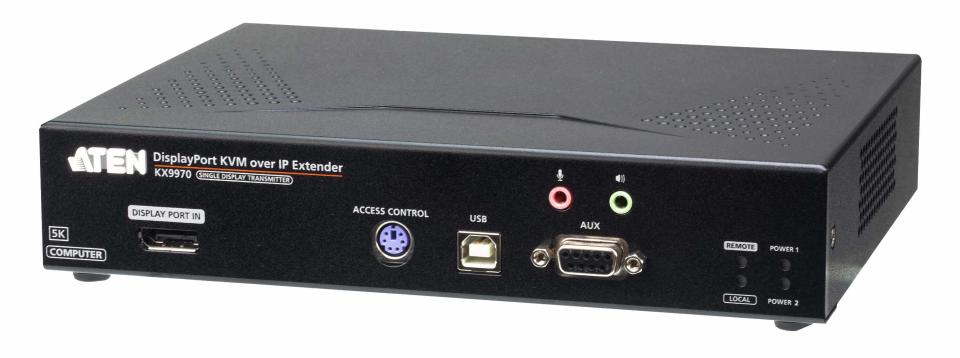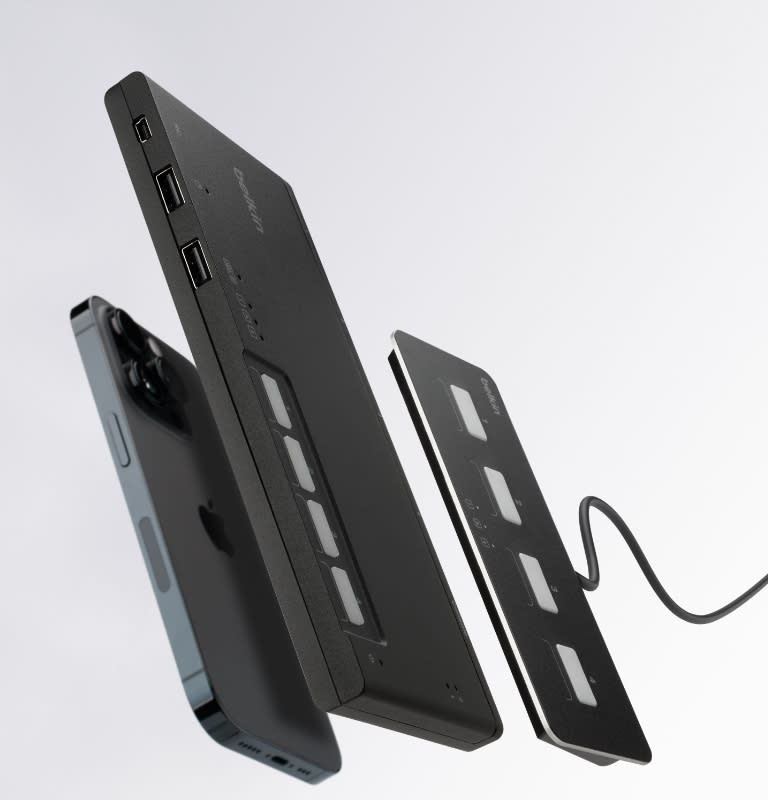Making the Case for KVM

Economy, convenience, and simplicity are constant goals for AV installers, operators, and users—which happens to be the sweet spot for KVM technology. Short for keyboard, video, and mouse, KVM allows users to control and switch between multiple computers while using a single set of peripherals.

For anyone who uses multiple computers at a workstation, KVM is an easy sell. Using KVM switches to control multiple computers from one user interface centralizes control, but it also reduces the number of peripherals that need to be purchased and eventually replaced. “Additional benefits of KVM switches include decreased desktop clutter and improved worker productivity and situational awareness,” added Erin Glenn, Belkin International’s director of product management, secure KVM.
Advanced Functionality
According to "A Close Look at Modern Keyboard/Video/Mouse Switching," a white paper by Tony DeKerf and Gary D. Davis from 1995 (and revised in 2000), the ability to use a single keyboard, mouse, and monitor to control multiple computers via a KVM switch was introduced, in rudimentary form, back in the 1980s. Decades later, many advances have made KVM switching far more efficient and secure.
[Executive Q&A: Embracing Alliances]
“Ongoing enhancements include improved resolution and contributing to an improved user experience—certain KVM solutions now accommodate up to 5K resolution,” said Aaron Johnson, product manager with ATEN Technology. “Additionally, recent advancements in KVM technology facilitate audio and microphone sharing. The integration of virtual media also enables the utilization of local drive resources, facilitating remote installations, patch upgrades, and other related tasks as needed.”

KVM has also been expanded to move beyond remote control of multiple computers. “Cameras, Bluetooth, and mass storage are now available to be routed using KVM as well,” said Aurora CEO/CTO Paul Harris.
“Over the years, secure KVM switches have advanced by enabling enclave switching over long distances,” Glenn added. “Existing technology allows extenders to deliver point-to-point video and USB across distances, but there's no way to switch the video path from enclave to enclave. The combination of KVM, extenders, and keyboard with integrated remote-control pad enables enclave switching and long-distance transmission of video/USB over copper or fiber infrastructure for audiovisual projects challenged by signaling limitations. This is ideal for remote desktops, conference rooms, command and control, and secure video access.”

Recently, even more capabilities have been added to KVM systems. “Modern features include Panel Array Mode, both in static and live configurations,” said Johnson. “The introduction of remote authentication and authorization passthrough enables users to leverage their own active directory credentials. Boundless Switching is also worth noting, facilitating the seamless transfer of mouse or USB signals among connected computers. There's also been significant improvement in speed over the years, with certain newer models now tailored for compatibility with 10GB networks."
Let's Add IP
The ability to connect distant devices over IP networks have fundamentally transformed the nature of AV, and KVM is no exception. KVM-over-IP switches have extended traditional KVM capabilities by "allowing remote access and control over IP networks,” explained Dan Holland, marketing manager with IHSE USA. “While traditional KVM is ideal for local setups, KVM-over-IP provides flexibility for remote management. The choice between them depends on specific use cases and requirements, with both having their advantages.”

“KVM and KVM-over-IP serve distinct purposes in terms of remote access to devices,” Johnson agreed. “Standard KVM necessitates physical proximity, either at the rack or in-person at the desk, wherein a local user employs a KVM to control and access all devices connected to it."
In contrast, KVM-over-IP enables remote access from separate buildings or even separate countries. "Users can simply open a web browser, enter the KVM's IP address or name, and log in remotely. Again, this stands in contrast to local-only KVM setups, which are limited by cable distance between the KVM and the server, typically ranging from 10 to 15 feet, depending on signal requirements," Johnson said. "The key advantage of KVM-over-IP lies in its capacity for unlimited distance, offering flexibility for users located globally to connect and manage devices through a web interface.”
[Executive Q&A: Changing the Topology of AV]
Not surprisingly, the difference between working locally or across the globe results in some differences between KVM and KVM-over-IP in connectivity, access, and scalability, particularly in data center and server room use cases. “Secure KVM switches use physical cables to connect host devices and KVM-over-IP relies on network connections," Glenn offered. "KVM-over-IP supports multiple user connections and remote access and control. Secure KVM switches require single-user access and control. Secure KVM switches are hardware-based, where KVM-over-IP includes hardware and/or software solutions.”
Expanded Uses

Most people associate KVM with command-and-control functions as executed within government, military, or prison settings. However, Holland said its applications extend to various industries, including broadcast, post production, healthcare, and simulation. This is because KVM “facilitates efficient content creation, collaboration, and system management.”
KVM is also useful in many other applications, such as small or medium-sized server rooms, integration into production lines, control rooms, and remote/branch office data centers. “In the context of secure government applications, KVM facilitates users in accessing computers classified as either government-classified or unclassified, all within the same switch,” Johnson said.
In a conference room, KVM can be employed to link the room’s peripherals into the presenter’s laptop computer via its USB port, providing them with centralized device control. "We can also do 'roaming mouse,'" said Harris. "When you move the mouse from one edge to the next, it will automatically jump computers."

Seamless cursor-based switching is available in Belkin's Secure KVM Series. "In Secure KVM, seamless cursor-based switching transitioned to Guard Mode or Key Press Seamless Cursor Switching [KPSCS]. Instead of using front-panel buttons to switch between channels, KPSCS automatically switches the mouse and keyboard from one channel to the next once the mouse cursor crosses a display border onto the adjacent display while the correct keyboard key is held down," Glenn added. "Guard Mode requires a key press or a specific action, driving the mouse cursor from display to display. This ensures situational awareness as operators switch across secure enclaves.”
KVM can do even more when harnessed to a Display Management System (DMS). “It provides centralized control, monitoring, and configuration of KVM systems, enhancing overall efficiency while giving users a more secure way of directly accessing multiple computer sources,” said Holland.
Meanwhile, security is a prime feature of KVM-over-IP. “You need to keep it secure with encryption and, if using AVoIP, isolate the network switch,” Harris said. “It is important to find ways to manage and limit what can or cannot be sent over the method of extension."
As for the future of KVM? “It looks promising, with continuous advancements in technology,” Holland said. “We anticipate further integration with emerging technologies, enhanced virtualization support, and the development of more intuitive and user-friendly interfaces.”
“Looking ahead, KVM tech might shift toward fiber-based extensions,” added Johnson. “We're seeing more modular-format KVM switch boxes connecting physically to computers, but the future could bring remote virtual machine control. Or we might expect improvements like higher frame rates and faster USB signals for gaming applications.”

